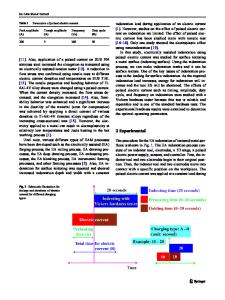Effects of Surface Texturing on Cell Adhesion for Artificial Joints
- PDF / 815,427 Bytes
- 6 Pages / 612 x 792 pts (letter) Page_size
- 55 Downloads / 366 Views
W4.8.1
Effects of Surface Texturing on Cell Adhesion for Artificial Joints 1
B. Shi1, A. Fairchild2, Z. Kleine1, T. Kuhn1, and H. Liang2* Department of Chemistry and Biochemistry; 2 Department of Mechanical Engineering University of Alaska Fairbanks, Fairbanks, AK 99775
ABSTRACT One of the major issues of joint implants is their loss (detachment) and subsequent failure after a limited number of years in application. Understanding and improving cell adhesion to implanting materials to extend lifespan, lubrication, and self-regeneration properties are therefore substantially important. In this research, we investigate effects of surface properties, such as wettabilty and texture on cell culture for the purpose of biotribological applications. Materials used are polyurethane, polyvinyl alcohol, and glass. Surface analysis indicates that surface structures have profound impact on cells growth. INTRODUCTION Despite the success of surgical implants, materials used in these procedures still do not satisfy the demands of a durable functioning joint. Current synthetic materials, undergo degradation after 10 to 15 years of use1. There are several common failure types. Studies have suggested that the macrophage response to phagocytosis of particulate wear debris, occurring in interaction between the cement and bone, is an important causative factor in osteolysis, leading to eventual loosening of joint surfaces2. Due to significant localized contact stresses at the ball/socket interface, small regions of implant materials tend to adhere to the metal or ceramic ball3. During the reciprocating motion of normal joint use, fibrils will be drawn from the adherent regions on the polymer surface, and these break off to form submicrometer-sized wear debris. Over time, sufficient bone is resorbed around the implant to cause mechanical loosening which necessitates an implant replacement or revision, costly and painful options4. The particulate debris has emerged as a major factor in the long-term performance of joint replacement prostheses5. When present in sufficient amounts, particulates generated by wear, fretting, or fragmentation induce formation of an inflammatory, foreign-body granulation tissue that has the ability to invade the bone-implant interface6 7 8 9 10 11 12 13 14. This may result in progressive periprosthetic loss of bone, a loss that threatens the fixation of prostheses inserted with or without cement 15, 15, 16. The motivation of this research is to gain the fundamental understanding of one of the most basic elements or “building blocks” of artificial joints. We investigate the interactions of fibrablast cells and synthetic materials. We investigated the effects of materials structure and surface properties on cell culture using experimental approach. A series of materials were investigated. The surface texture and wettability were evaluated on synthetic materials before and after cell culture. An important impact of this research is to understand and improve the adhesion of implants that will enable implants to st
Data Loading...











